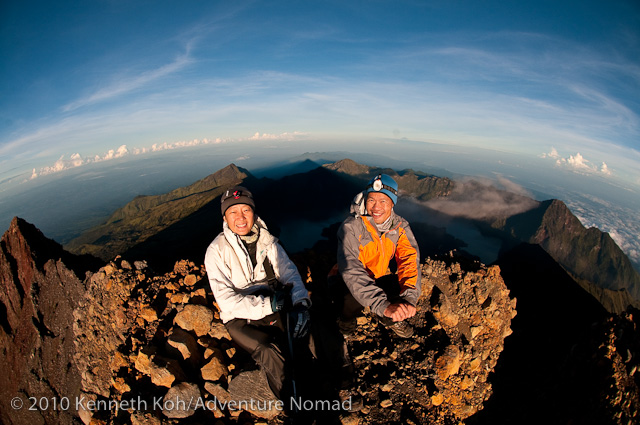Approaching the summit of Mt. Rinjani at dawn. Nikon D300, 10.5mm.
Trekking Mt. Rinjani isn't for the faint of heart. The volcano is active, and although the last significant eruption occurred a year ago on May 10th 2009, smaller eruptions occurred every 4-5 hours during our trek there last week.
Me, standing on the crater rim as we begin our pre-dawn climb to the summit. Photo © Laura Liong. Canon 7D, 15-85mm.
Mt. Rinjani is 3726m tall and is located on the island of Lombok, Indonesia. Trekking information is hard to come by, and is usually out of date. The best time to go is during the cool and dry season from May to October. If you are trekking down into the rim (ie. down to the crater lake), you'll take your chances during the wet season as the trail is pretty rugged.
What's a climb without a summit photo? Laura and I on the summit of Mt. Rinjani.
The trek is guided, and porters will carry the camping gear, food and water. If required, you can also arrange for a porter to carry your personal belongings.
Chilling in the hot springs after coming down from the summit. Nikon D300, 10.5mm.
We did the 4-day trekking option, starting from Sembalun Lawang. The first day was relatively easy, starting out at Semlabun Lawang (1156m) and making our way up the grassy slopes to our camp on the East crater rim. Our second day was long. It began with a pre-dawn start from our campsite on the crater rim, to the summit and down into the crater to camp at the lake shore, where we enjoyed a soak in the nearby hot springs.
Thar She Blows! An eruption early in the morning. Nikon D300, 16-85mm.
The mornings are usually the best time for views, as the clouds tend to roll in by late morning, obscuring the views. Our third morning began with a thoroughly enjoyable walk along the shore of Danau Segara Anak (Child of the Sea Lake), with great views of the volcanic cone, Gunung Baru Jari, and made our way up the West crater rim. The volcano is active, and erupted every 4-5 hours during our trek. This forced us to wear masks which filter out volcanic ash which would rain down following each eruption.
Volcanic ash covers our tent in the morning.
Our fourth day was flexible, depending on how far we got on day three. In truth, we probably could have made another long day and walked all the way out on day 3, but we chose to spend our last night in the jungle and had a short walk out to Senaru.
Trekking along the shore of Danau Segara Anak with the active volcanic cone behind. Nikon D300, 16-85mm.
The rim-summit-lake-rim (Senaru to Sembalun or vice versa) trail described in here is probably best suited to the experienced trekker or the adventurous traveler. It is a rewarding experience with fantastic scenery, but visitors will have to put up with the sorry state and significant trash at the campsites and rest stops.
More pictures on Flickr.








7 comments:
You had MUCH better weather than I did when I trecked Mt Rinjani in September. Great pictures.
http://scottfoto.blogspot.com/2009/10/chapter-2-climb.html
Hi Scott,
I think we had a bit of luck. Although it rained on us some afternoons and was mostly cloudy and hazy from late morning til evening, the early mornings were crystal clear and that's when we got most of our good shots :o)
Ken
Awesome pics! We just completed the trek at the end of June 2010. We enjoyed it a lot, the volcano has become a lot less active from what you described. It still goes off every few hours but just ejects a small puff of smoke.
You can read about our trip here: http://www.noodlesandcurry.com/2010/lombok/gunung-rinjani-trek-part-1/
Interestingly enough, I did the trek with a D300 and a 10-24mm lens, and carried it all in a ThinkTank SpeedFreak waist pack. It was perfect for getting to the summit, even though the camera is a bit heavier than I would have liked, the bag was incredibly comfy.
Hi Michael,
The D300 with the 10-24mm is a nice setup. I've thought of doing it with the same setup, although I'd probably add a 50mm to complement it. Also, I'm looking into getting something lighter than the D300, like whatever is going to replace the D90.
Nice pics on your blog :o)
Ken
One lens not to overlook is the 35mm f1.8. I bought one for my girlfriend and she jealously guards it from me. That lens with the D90 makes a really fast and compact setup.
I have been eyeing the 50mm 1.4 though.
My typical travel kit is the Nikon 16-85mm, Sigma 105mm macro (the Nikon is too big and too expensive for not much better IQ), Nikon 10-24mm and SB600 Speedlight. It's small enough and versatile enough for most of the photos I take.
Hi Michael,
Yup, the 35mm F/1.8 is a good lens, and a better lens for all-around low light use than a 50mm, which is a bit too long on a DX cropped sensor body.
These days, if I take the 50mm F/1.4, I'm likely to pair it up with my 12-24mm, instead of with the 16-85mm or 18-200mm, for a lightweight, wide-biased setup.
You've got an interesting setup. I'd be interested to see more of your shots with the SB600.
Cheers :o)
ok makasih banyak gan
Post a Comment